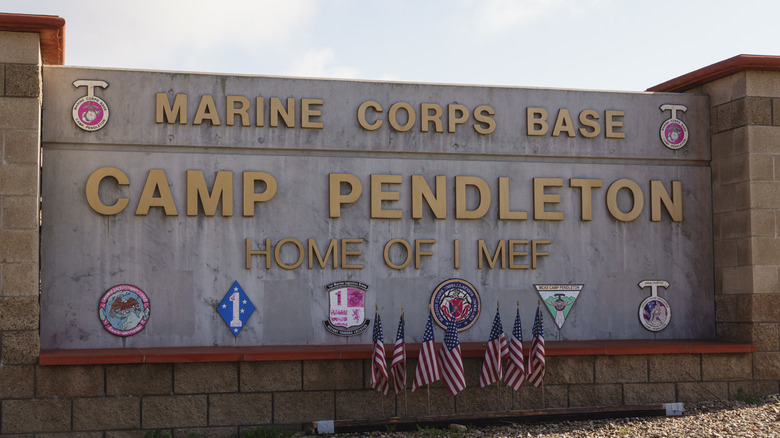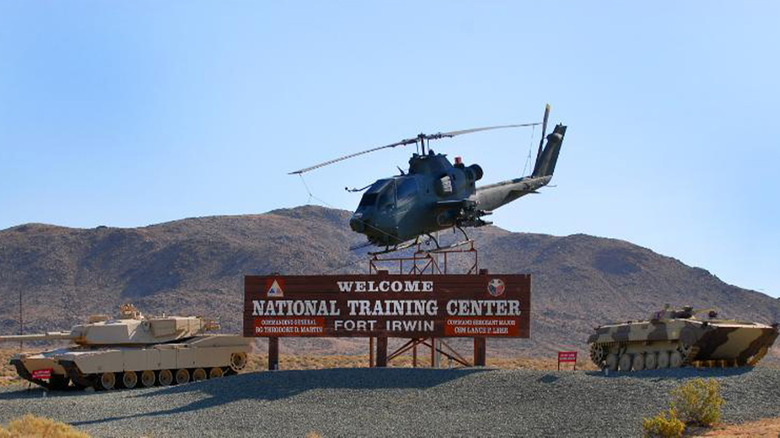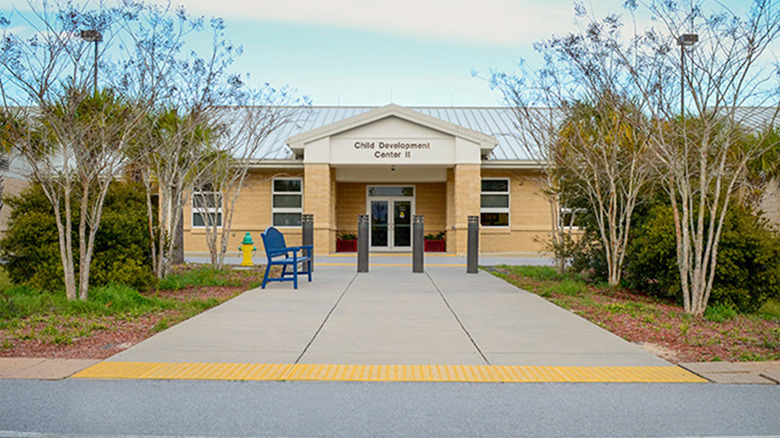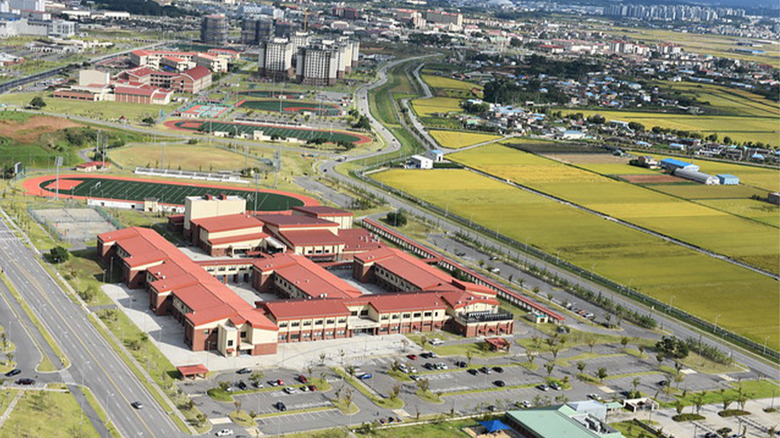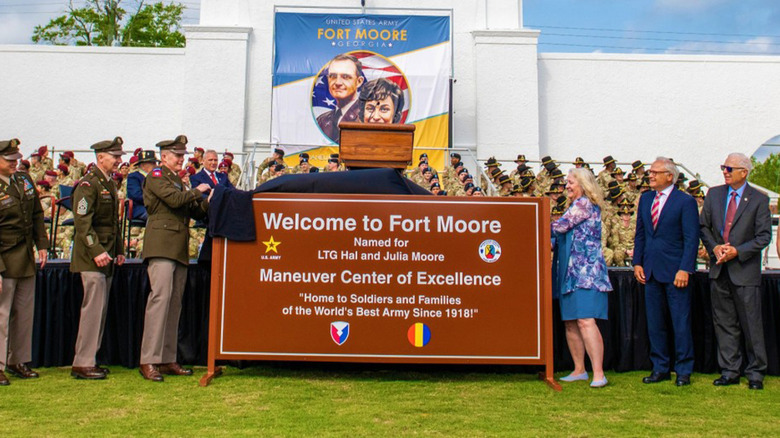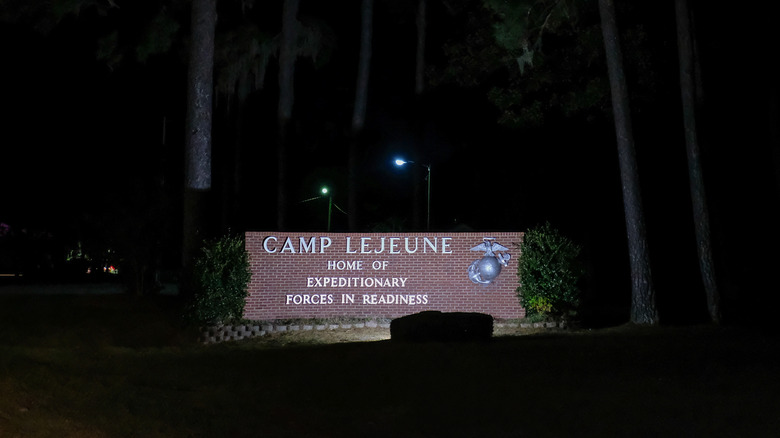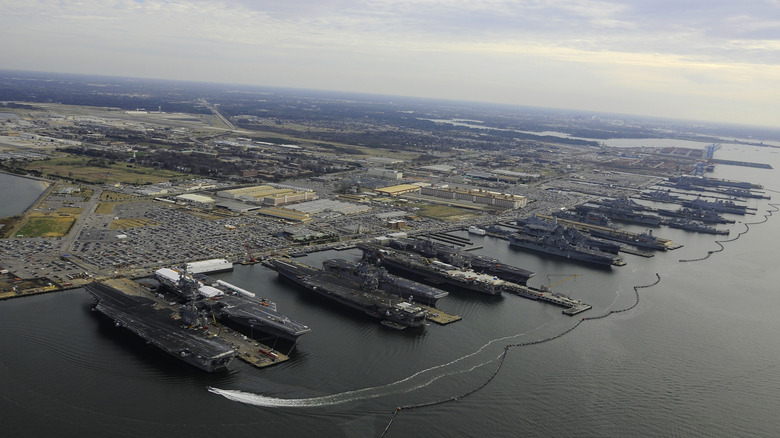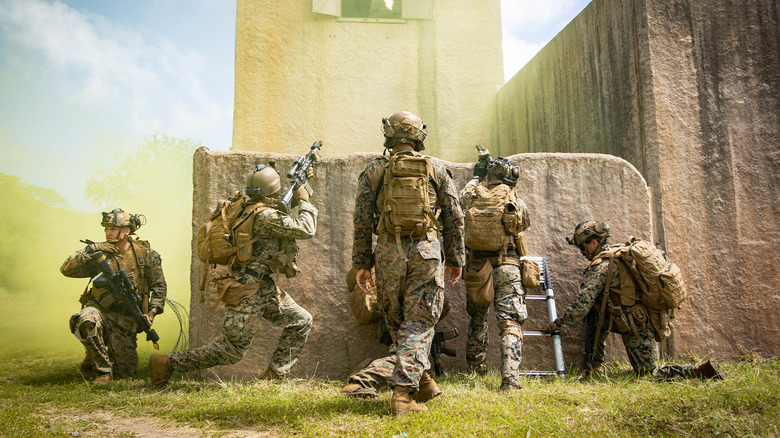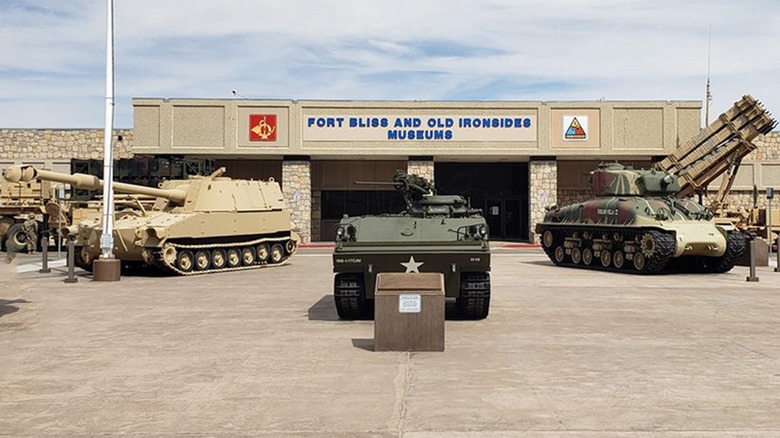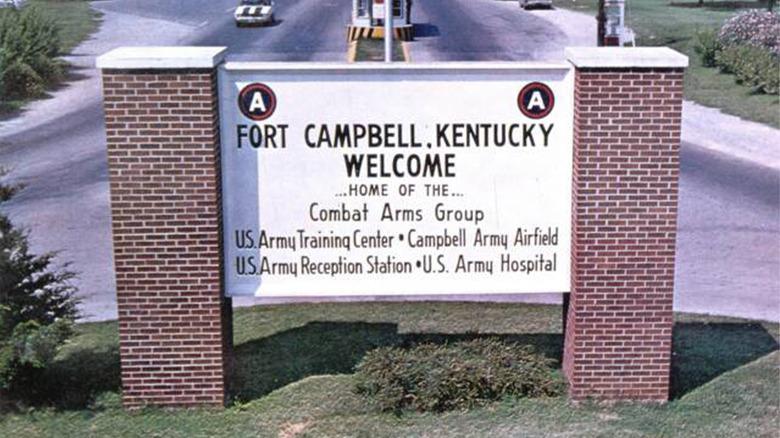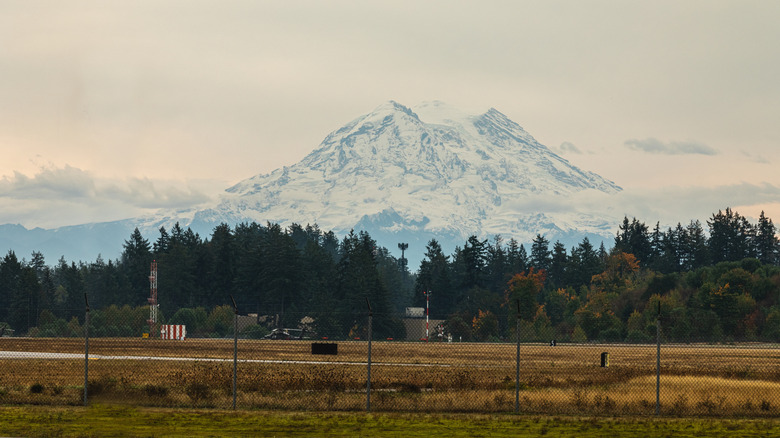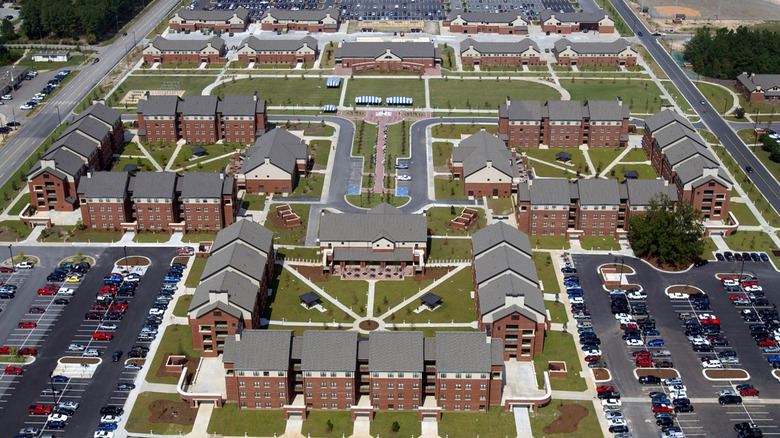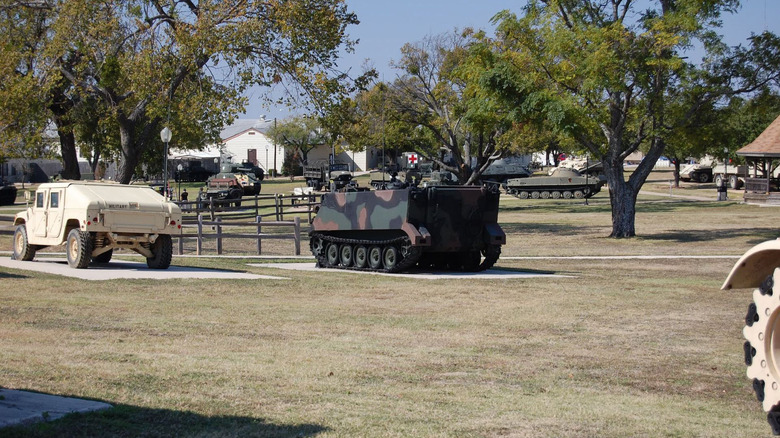10 Of The Biggest US Military Bases In The World, Ranked By Population
The U.S. had around 2.86 million people in the military as of September 2023. Those folks are spread out among the many duty stations that the U.S. runs. As of 2021, the U.S. had over 500 military installations in the country itself (many of which are in North Carolina) and around 750 in 80 countries total when you count international bases. The bases range in size tremendously, both in terms of land mass and population. Generally speaking, when people refer to large bases, they usually refer to population size.
There is some humor to the size comparisons of military bases. For example, the U.S. military formally recognizes Norma Brown Air Force Trainer as the smallest military base. For reference, it's a tabletop model of an Air Force base used for training fire protection specialists. The smallest actual base is Navy Point, which is a scant four acres in Sackets Harbor, New York. While fun, that's not why you're here. You're here to see the largest military bases that the U.S. controls.
For this list, we used the Military OneSource website. It's an official Defense Department website that updates its information about once a year. That's important because population figures at military bases can vary by tens of thousands or even more when referencing online lists. We found Military OneSource to be not only consistent but also likely to have up-to-date information as a military-owned website.
Fort Irwin (honorable mention)
Fort Irwin typically wouldn't make a top 10 list when it comes to the most populous military bases in the U.S. or abroad. It boasts a population of approximately 20,000, which comprises a mixture of active duty soldiers, family members, and civilians. The base is located northeast of Barstow, California, which is between Las Vegas, Nevada, and Los Angeles on a map. It's had many uses over the years, but currently houses the National Training Center, where the military trains soldiers in realistic battlefield missions.
The reason we wanted to mention Fort Irwin is that it's one of the largest bases in the U.S. in terms of land mass. When it was first established in 1844, it was mostly a small camp where U.S. Army soldiers acted as security for settlers of California. At the beginning of World War II, President Franklin Roosevelt ordered 1,000 square miles of the California desert to be turned into what would eventually be known as Camp Irwin. The base was officially renamed in 1942 and was in and out of use until the U.S. military saw it fit to put the National Training Center there.
At 1,000 square miles, Camp Irwin is three or even four times larger than most of the bases on this list in terms of overall landmass. That's worthy of an honorable mention.
Eglin Air Force Base (honorable mention)
Eglin Air Force Base also gets an honorable mention for much the same reason Camp Irwin did. The base doesn't break any attendance records at around 19,000 people, but it does serve its community of around 71,500. The base is nestled into the western Florida Panhandle about three miles southwest of Valparaiso, Florida. It's close to a lot of places down there, so it's not uncommon for soldiers to live in the surrounding area instead of on base specifically, which makes its true population a little difficult to narrow down.
Another reason it's so hard to pin down the exact population is that Eglin Air Force Base is quite massive. At around 640 square miles, it's the largest individual U.S. Air Force base in the entire military. The main reason for this is the airspace above the base, which allows pilots to train in a large area without bothering civilians too much. Modern fighter jets can go hundreds of miles per hour, so the huge amount of space definitely helps.
On the ground, a sizable portion of the base is actually protected land. Part of the base protects a 100-mile stretch of the Northwest Florida Greenway and the base has buffer zones between it and nearby lands to protect them as well.
Camp Humphreys
We start out the official list with Camp Humphreys. This base serves as the main outpost for U.S. soldiers in Korea and sits roughly 60 miles from the North Korean border. The nearest big city is Pyeongtaek, and the base is about 40 miles away from Seoul, the capital of South Korea. Among other accolades, Camp Humphreys has the distinction of being the largest military base not on U.S. soil in terms of both land mass and population. According to the members of the rock band Hoobastank, the base is also eerily reminiscent of Texas.
As of 2024, Camp Humphreys houses over 40,000 people, including Department of Defense service members, civilian contractors, and their families. The camp is on approximately 3,500 acres of land, which translates to about 5.5 square miles. Technically, Fort Sill has more people than Humphreys, but we wanted to include at least one base outside the U.S. itself.
The base originates from a 1919 construction project by the Japanese military that became the Pyeongtaek Airfield. Decades later, the airfield was rebuilt by the U.S. military and renamed K-6 before finally becoming Camp Humphreys in 1962. The base also used to be larger but returned much of its land to South Korea in the early 2000s before expanding again in the late 2010s.
Fort Moore (formerly Fort Benning)
Fort Moore — known as the Home of the Infantry — is one of the largest training centers for the U.S. military. As its nickname suggests, it serves as a basic training center for infantry and airborne soldiers. It has some good history as well. Moore was home to the 555th Parachute Infantry Battalion, which is known as the first all-black unit of paratroopers. The base resides in Georgia, right on the border of Alabama and just south of Columbus, Georgia.
The base is the first on the list to combine size in both population and landmass. It covers 284 square miles, or around 182,000 acres. The base itself houses approximately 63,000 people, with over 316,000 people in the surrounding area. Groups consist of soldiers in training, active and reserve military, their families, civilians, and even some retired military. The area itself is commonly referred to as the Tri-Community and consists of Fort Moore, Phenix City, Alabama, and Columbus, Georgia. Thus, you may see the population be much higher on other sites since it's not uncommon to group all three together.
Fort Moore always knew what it wanted to be when it grew up. From the moment Congress established it as a permanent base in 1920, Moore — formerly Fort Benning — was all about training the next generation of infantry, which it still does today.
Camp Lejeune
Camp Lejeune has come a long way since its humble beginnings in 1941, when it was essentially a tent city with a tobacco barn and a farmhouse. The base received its name in 1942 and has since expanded into one of the largest U.S. military bases. It sits northeast of Wilmington, North Carolina, and southeast of Jacksonville, North Carolina, along the New River. The base is valued as a training center thanks to its proximity to the Atlantic Ocean, giving Marines a chance to train both on land and in water.
All told, the base has a population of approximately 100,000 people, including active duty, family members, civilians, and retirees. The base itself is also quite large at roughly 153,000 acres, which is a hair under 240 square miles. Around 14 of those miles are beaches where Marines can train. In addition, there is a Coast Guard and Navy presence there, so it's not all just the Marine Corps. For the most part, Camp Lejeune is best known for having a bunch of entry-level and formal schooling for Marines.
Part of its popularity is because it trains so many soldiers, but it's also just a decent place to live. It is a seven-time recipient of the Commander-in-Chief's Award for Installation Excellence. Bases receive that award for proper asset management and developing quality programs for soldiers.
Naval Station Norfolk
Fans of the long-running TV show "NCIS" are likely well aware of Naval Station Norfolk because the cast makes frequent visits there. There is a reason why a Navy-based TV show would take place at NS Norfolk, and it's because it's the largest individual Navy installation that the U.S. military possesses. The base is settled into the Southeastern corner of Virginia, nestled alongside Newport, Hampton, Norfolk, Portsmouth, Virginia Beach, Chesapeake, and Suffolk. The area is collectively known as "Hampton Roads," and the entire area houses around 1 million people.
The base itself houses a ton of people as well. Per Norfolk Naval Housing, approximately 82,000 servicemembers live on base along with 29,000 civilians, who primarily comprise family members and contractors who work on base. That makes it slightly more populated than Camp Lejeune. The base itself sits on 4,300 acres of land, or approximately 6.7 square miles. It's much smaller than other military installations, but most of its landmass sits on the water, making it the largest Naval complex in the world.
Norfolk is home to 75 warships and submarines, including five of the Navy's 12, serving as home port of the carrier Harry S. Truman as well as the smallest ship in the U.S Navy. Modern warships can house thousands of people, but by most accounts, sailors in the area usually rent something nearby, like an apartment or a house, depending on their family size.
Camp Pendleton
Much like Camp Lejeune, Camp Pendleton was established during World War II in 1942. Unlike Lejeune, Pendleton is steeped in a bit more history. Initially, the land on which Pendleton sits was originally called Santa Margarita. It was home to Franciscan missions before becoming Rancho Santa Margarita and eventually Rancho Santa Margarita y Las Flores. The Marine Corps bought the property in 1942 with the express intent of making the largest Marine Corps base in the U.S. military. Per its placement on this list, they were successful.
Camp Pendleton has only gotten bigger since it was deemed a permanent base in 1944. It currently houses around 175,000 people. However, those numbers are subject to debate. In terms of active duty and military families, it's actually the second largest base behind Camp Lejeune. However, Pendleton has 77,000 retired vets living in the area who all retain full base privileges. So, if you count the retired vets, Pendleton is larger. If not, Lejeune is larger. We leave the determination on whether the retired folks count up to you, but we did include them in our numbers.
In terms of land mass, Pendleton covers 125,000 acres, or about 195 square miles. That means it's physically smaller than Lejeune. Both Marine bases pale in comparison to 29 Palms in terms of space, with 29 Palms having roughly 1,000 square miles of land.
Fort Bliss
The U.S. military bases in the top five are also most likely the ones people are familiar with, starting with good old Fort Bliss. It's also one of the older bases on the list, having been established in 1848 as a protection base for people settling in Texas and further west. It has switched hands multiple times, first with Texas Confederates and later by Californian Union troops. It was even abandoned for a while in 1876 before becoming a permanent installation in 1878. Today, it serves as a training base.
Fort Bliss has the distinction of being huge in terms of both population and land. Approximately 175,000 people live there today, but the number may vary greatly depending on who you ask because it's tucked right up against El Paso, Texas. It also takes up 1.2 million acres, or around 1,875 square miles. As the old saying goes, everything is bigger in Texas.
Bliss puts that land to good use. Its expansive space is large enough to train on virtually every weapon in the U.S. Army's arsenal. Yes, that also includes missiles. That is precisely what they do there for the most part, as much of the land is taken up by gun ranges and other training facilities. Per the Army, even the living facilities are top-of-the-line, so it's a decent place to live.
Fort Campbell
Fort Campbell has one of the more humorous histories of any military base on the list. It's right on the Kentucky and Tennessee border, and it's largely assumed that the base is actually in Kentucky. However, in its early days, the post office was on the Tennessee side of the border, and since the mail system works the way it does, the base was technically in Tennessee first. Eventually, the camp commander requested that the post office be moved to Kentucky, so now it's a Kentucky base.
Campbell's post office issues aside, it's one of the largest bases in terms of population. It's the first on the list to crack 200,000 people with a population of 241,000, give or take. Much like others on the list, there is a sizable retired population here as well, but it would still be on the list even without them. Those people live, train, and work on 105,000 acres — or roughly 164 square miles. Approximately two-thirds of that land is in Tennessee, so the base's insistence on being in Kentucky is doubly befuddling.
In terms of overall history, Fort Campbell flies under the radar. It was established in 1941 and was used during World War II to house prisoners of war. Otherwise, its biggest claim to fame is the Screaming Eagles, a parachute-turned-air-assault unit that was part of the D-Day invasion during World War II.
Joint Base Lewis-McChord
Joint Base Lewis-McChord — colloquially known as JBLM — has an interesting name for good reason. It was initially two bases that existed near each other that were pushed together into a single military installation. It started life as Camp Lewis in 1917 during World War I. During World War II, Lewis gained McChord Field, which was essentially an airfield facility. McChord was eventually split into its own Air Force ase following the creation of the U.S. Air Force. The two merged once again in 2010 and immediately became one of the largest U.S. military installations.
Being essentially two bases in one gives JBLM a cheat code for this sort of list. The base houses 250,000 people. Since it is an Air Force base as well, the various airstrips need plenty of room. In this case, about 647 square miles or about 413,000 acres. That makes JBLM among the largest bases in the U.S. based on both land coverage and population. In fact, if you combined the final two bases on our list, they would still be smaller in terms of land mass than Lewis-McChord.
The base is also among the largest on the U.S. West Coast. It sits between Seattle and Olympia in Washington state. It saw plenty of use in World War I and World War II and has been fairly active since the Cold War.
Fort Bragg (formerly Fort Liberty, formerly Fort Bragg)
In the early 2020s, the U.S. military renamed several bases that were honoring Confederate generals. Fort Bragg — named for General Braxton Bragg of the Confederate army — was a part of that and was initially renamed to Fort Liberty in 2023. In a somewhat comical twist, the base was renamed again in early 2025 back to Fort Bragg, this time in honor of Pvt. First Class Roland L. Bragg, who served in World War II. With its name settled, Fort Bragg was able to get back to being one of the largest U.S. military installations.
The population for the base is difficult to narrow down specifically, but most places we looked have Bragg at somewhere around 300,000 people. That makes the installation about as populous as Pittsburgh, Pennsylvania, or Cincinnati, Ohio. Most of those consist of active-duty and reserve service members and their families, but Bragg does support a rather large population of retired folks as well. In terms of size, Bragg is pretty sizable, spanning 160,000 acres or about 251 square miles.
Fort Bragg is perhaps best known as the home of the 82nd Airborne Division, which makes 100,000 parachute jumps every year. They certainly have the space to do it. Bragg also shares territory with Fayetteville, North Carolina. When compared, Bragg is actually larger than Fayetteville in terms of both population and size.
Fort Cavazos (formerly Fort Hood)
The final base on the list today is Fort Cavazos, which is formerly known as Fort Hood. It is yet another base that came into service during World War II. Like many of the larger bases, Cavazos is all about training troops and, thus, has a rather large population of infantry along with the 1st and 2nd Armored Divisions. In short, they train armored units equipped with tanks and Stryker vehicles, and that's part of why Cavazos is so large.
The exact population is difficult to pin down. The base's media center has the population at around 473,000, while Military OneSource says it's higher at 635,000. It doesn't really matter which one you go with because they're both bigger numbers than all the other bases. To properly conduct training with tanks, a tremendous amount of land was given to the base, to the tune of about 342 square miles, or roughly 218,000 acres. So, ultimately, it doesn't matter how you count it; Fort Cavazos is absolutely massive, and there are a ton of people there.
The base was also part of the renaming system to remove Confederate generals from base names, so folks from way back may know this one better as Fort Hood. It was redesignated as Fort Cavazos in honor of General Richard Edward Cavazos in 2023. Most notably, Gen. Cavazos was the first Mexican-American to be named Brigadier General in the U.S. Army.
